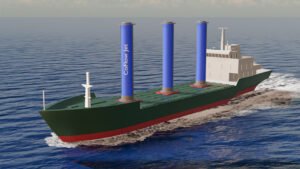ButSpeak.com
News which Matters.

CoFlow Jet’s new wind-driven system promises significant fuel savings for cargo ships using stationary cylinders without moving parts, offering a green solution to decarbonize the shipping industry.
Looking like a set of bridge supports mistakenly installed on a cargo ship, the new wind-driven system by startup CoFlow Jet promises to revolutionize maritime fuel efficiency. This innovative system, which uses stationary cylinders without any moving parts, could potentially reduce ship fuel costs by up to 90%.
With rising fuel costs and increasing governmental mandates pushing for carbon neutrality in shipping by 2050, the drive to enhance the efficiency of cargo ships while cutting emissions is stronger than ever. CoFlow Jet’s approach revisits the age-old concept of wind propulsion, yet with a modern twist.
Historically, sails have propelled ships for millennia and were common in commercial transport until the post-World War II era. However, their decline in the cargo market can be attributed to two main issues: scalability and reliability in diverse wind conditions. Enter GeCheng Zha, a professor of aerospace engineering at the University of Miami, who proposes a variant of the Flettner rotors developed in the 1920s, but with a significant innovation.
Flettner rotors are large rotating cylinders that generate aerodynamic thrust perpendicular to the airflow over them. Unlike these traditional rotors, the CoFlow Jet cylinders do not rotate. Instead, they draw in a small amount of air, pressurize it using an impeller, and expel it from another part of the cylinder. This process creates a pressure imbalance, producing substantial thrust along the full length of the cylinders.
Zha asserts that this method provides a highly effective wind propulsion system capable of delivering 100% of the necessary thrust to move the ship, thanks to the system’s high lift coefficient and drag reduction. Unlike Flettner systems, CoFlow Jet’s design has no rotating parts and can offer a fuel reduction of up to 50% for large cargo ships and up to 90% for smaller ones.
While the idea of achieving a 100% fuel reduction by solely using sails is not new, the reliability and efficiency of the CoFlow Jet system provide a more practical and consistent solution. Additionally, the system’s ability to be retrofitted to existing vessels and retracted for harbor entry and exit adds to its practicality.
“What’s old is new again,” Zha remarked. “With today’s technological advancements, wind-assisted propulsion becomes a viable and efficient alternative to diesel engines. It’s an environmentally friendly way to decarbonize the shipping industry, which accounts for about 3% of global greenhouse gas emissions. The shipping industry, traditionally resistant to change due to the power of diesel engines, now faces mounting pressure to adapt, willingly or otherwise.”
As the shipping industry grapples with environmental and economic pressures, innovations like CoFlow Jet’s wind-driven system could pave the way for a greener and more sustainable future on the high seas.